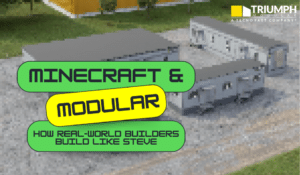Ten Steps Required for Building and Occupancy Permits
Triumph Modular Inc. has been constructing and installing commercial buildings in Massachusetts and the surrounding New England states for over twenty-five years. We have found that documentation required to obtain all permits varies from project to project. I have created this permitting guide to make the process a little easier for you.
I had previously touched on the topic of permitting as the 4th Cone in my Guardrail Series, Guardrail #4: Permitting and Soft Costs. For a refresher on these 6 critical areas of focus to help the construction industry have more success, please start here: Introducing Guardrailed Construction.
The earliest phase of notifying city or town officials about a project is sometimes referred to as enabling, planning, zoning, and/or site plan review. This early phase requires input from both the client and the Triumph Team. There will likely be local zoning requirements and perhaps other regulatory approvals needed to construct. The Triumph Team will work with the client’s representatives to identify these permits and meet with local officials and agencies as required. The Triumph Team will provide leadership in these meetings and will provide all graphic materials needed. Often Triumph will hire its own Architect or will work with the Owners’ Architect during this phase, in a transparent manner.
At the building permit stage, the Triumph Team will provide all the documentation needed to obtain the necessary Building Permits. Construction Documentation, also referred to as 100% Construction Documents, for a building permit typically consists of the ten steps below. Please note that most often there are multiple iterations of plans, questions, and answers and that the following is not an exhaustive list.
Ten steps to obtain a building permit:
- Architectural/Engineering Plans & Specifications (also referred to as Construction Documents) – Including all architectural, structural, mechanical, electrical, plumbing, and fire protection plans. These plans will incorporate the modular unit plans (described below and designed specifically for this project) and will integrate these modules into the overall building. This includes common spaces and other areas that provide the framework for the modules. These plans will depict the entirety of the new building to be built, including a narrative Code Review indicating compliance with all relevant building codes. Specific requirements for modular buildings built and inspected off-site will also be included.
- Site Plans (referred to as Civil Engineering Plans) The Civil Engineer is typically contracted by the Owner directly with the Triumph Team directing and coordinating their efforts as follows:
- Preparing existing condition boundary and topographic surveys indicating all existing drainage, utility lines, sewage lines, trees, and any other structures in or on the land.
- Developing a site plan locating the building proposed by the Triumph Team along with all walkways, roadways, and other site features as required.
- Arranging plans for proposed utility lines and connections (gas and electric), domestic and fire protection water lines, septic/sewer connection, and stormwater drainage plans.
- “Construction Control Documents”- Per Mass 780 CMR, Section 107, (or other state provisions) will be submitted with the building permit application for the following elements of construction: Fire Protection, Structural, Electrical, Mechanical, Architectural Drawings, and Site Plan.
- Fire Protection Code Review, Narrative, and Stamped Plans: Fire Protection Code Review and Narrative will be stamped by a Registered Design Professional or a Fire Protection Professional Engineer.
- Mechanical/HVAC and Ventilation plan: Detailed drawings of systems to code may be found in Architectural Plans or via separate detailed plan via a Mechanical Engineer. A licensed Mechanical Engineer will Stamp plans.
- Structural: plans of the building elements and foundation, Stamped by Architect or Engineer (Typically found on Architectural Drawings) or by Structural Engineer.
- Demolition Plans: (if relevant to the project) will include any removal of existing buildings.
- Access and Egress: Professional Engineer Stamped plans or narrative as to how people enter and exit the building, per Architectural Access Board regulations. Includes a Total Occupancy plan. See Related Fire Safety Plans above. Includes Decks, Ramps, and all Disabilities Act (A.D.A) compliance.
- Adjacent Building Code Narrative or Plans: Sufficient to show how Code issues associated with adding a building adjacent to an existing building are met. Set Back requirements and fire separation distances may be noted on the Architects Drawing set, Site Plan, or a separate page.
- Record Drawings: (also referred to as “As-Builts”), following the construction, will be brought to the building department at the time we seek Occupancy Permit.
Other Clarifications:
A Registered Design Professional is the same as Professional Engineer. Each is licensed as either an Architect or a PE.
A holder of a Construction Supervisors License (C.S.L) will coordinate the gathering of all required documents and stamped plans of all professional architects or engineers in this process and will arrange for all final inspections for the occupancy permit, coordinating all activities between landowner and building officials.
Permitting Cone Conclusions:
We hope this may provide some foundation or baseline as to what should be assumed a part of the first package for permits. This list may also be thought of as supplementing all those items required for the permit that you will find in the applications themselves, which are mostly found online.
To review previous blogs about Guardrail Construction, please see here:
- Project Fit
- Contracting Type
- Design Fully Detailed
- Permitting and Soft Costs
- Submittals and Approvals
- Closeout




